Overview of testo 570s digital manifold
When it comes to precision and reliability in HVAC diagnostics, the Testo 570s digital manifold stands out as a top-tier choice for professionals in the field. This advanced tool not only simplifies the process of measuring pressure and temperature but also enhances overall efficiency with its intuitive design and robust features.
The Testo 570s is equipped with an easy-to-read display that provides real-time data, allowing technicians to make informed decisions on the spot. Its ability to connect wirelessly to smartphones or tablets via Bluetooth further elevates its functionality, enabling users to analyze data remotely and generate comprehensive reports with ease.
Moreover, the Testo 570s offers various versions tailored to specific needs. Whether you require basic pressure measurements or advanced functionalities like superheat calculations, there’s a version suited for every application. This versatility makes it an indispensable tool for both seasoned professionals and newcomers alike.
Investing in a Testo 570s digital manifold means equipping yourself with a reliable partner that streamlines your workflow and ensures accuracy in your HVAC tasks. Don't settle for less—choose the Testo 570s and experience firsthand how it can transform your approach to system diagnostics.
Short Overview of the Testo 570s
We are paving the way for the future of intelligent long-term measurement on heat pumps, air conditioners, and refrigeration systems with the new Testo 570s. The testo Smart App's digital fault analysis makes it possible to promptly and accurately identify anomalies. Additionally, the Testo 570s is perfect for long-term measurements because of its enormous data buffer and the longest runtime in the world, up to 360 hours. The hybrid system that powers it consists of three batteries plus a rechargeable battery (USB-C). The Testo 570s' big screen offers a graphical progress indication in addition to a brief summary of all measured parameters.
All probes link to the manifold automatically via Bluetooth for simple temperature, vacuum, and current measurements. Stored programs facilitate the measuring procedure and allow for the automatic estimation of many plant characteristics, making the process even simpler. Just a few clicks in the testo Smart App can also enable future documentation and data transmission. Even in the most trying circumstances, the Testo 570s consistently provides excellent performance because of its great robustness with protection class IP54.
The Testo Smart App
The operator can examine anomalies and accurately detect them thanks to the Testo 570s' compatibility with the Testo Smart App. Data sharing and documentation are rapid and simple. Users can operate the second smart gadget remotely or utilize it as a second screen. On-site, users can digitally generate reports with images as PDF or CSV files, which they can then immediately send by email to clients or coworkers.
Important Features
Four-way valve lock on a digital manifold
Bluetooth compatibility
A lot of data memory
Measure refrigeration, air conditioning, and heat pumps over an extended period of time
It is possible to instantly attach optional temperature, vacuum, and current probes via Bluetooth
Extremely precise 0.25% fs
The measurements are shown on the big screen
Useful for the Testo Smart App
Long battery life of 360 hours
IP54 protection grade with auto-off feature
A2L and A3 refrigerants can be used with it
Trustworthy tester for both short-term and long-term data calculations.
General Technical Data
Operating Temperature: -20ºC to 50ºC
Storage Temperature: -20ºC to 60ºC
Battery Type: Built-in rechargeable battery: Li battery 18650 replaceable battery: 3 alkaline batteries AA
Battery life:
With built-in rechargeable battery: ≥220 h without Bluetooth®, without illumination,
≥120 h with Bluetooth® and illumination, With 3 AA batteries:
≥145 h without Bluetooth®, without illumination ≥75 h with Bluetooth® and illuminationAuto Power Off: After 10 minutes when not connected via Bluetooth®
Dimensions: 229 x 112.5 x 71mm
Weight: 1.3KG
Protection Class: IP54
Bluetooth® technology/range: Bluetooth® 5.0/ 150m
Compatibility:
Requires iOS 11.0 or newer/ Android 6.0 or newer
Requires mobile terminal device with Bluetooth® 4.0
Sensor Types
Pressure Measuring Range: -1 to 60 Bar
Temperature Measuring Range: -50ºC to 150ºC
Pressure accuracy at 22ºC: ±0.25% fs
Temperature accuarcy at 22ºC: ±0.5°C
Pressure Resolution: 0.01 bar
Temperature Resolution: 0.1ºC
Pressure Probe Connections: 3 x 7/16" – UNF, + 1 x 5/8" – UNF
Temperature Probe Connections: 2 x plug-in (NTC)
Pressure Overload: 65 bar
Choices Of Buying Testo 570s You've Got
You have basically 4 different kit options of testo 570s to purchase. Let’s take a look at all of them.
Okay, that is all for now. If you're interested in any of the 570s or its kits, please see our webstore here: https://www.mertehnika.lv/home-1/params/search/testo%20570s/
Introduction to paint thickness gauges
Let's talk a little about paint thickness gauges today. You need to know a few things before buying a paint thickness gauge.
What are the 3 measurement principles of
paint thickness gauges?
The best tools for measuring paint thickness over external car materials are handheld electronic equipment. There are three varieties available, and the choice is based on the part's size and form, the type of coating, and the material being painted. These devices measure using magnetic, eddy current, or ultrasonic methods.
Magnetic Principle for Steel
Steel is magnetic, hence magnetic (ferrous) gauges that use mechanical or electrical processes are used to measure the paint thickness over steel.
The components of a mechanical gauge are a graduated scale, a calibrated spring, and a permanent magnet. A measurement of thickness can be made by measuring the force needed to remove the magnet from the coated surface. Low-cost magnetic pull-off gauges offer coarse measurements that are helpful in identifying fillers under the paint, such as bondo. Detailers seldom ever use them. Usually, accuracy is within ±5%.
Eddy Current Principle for Aluminum
Utilizing an eddy current approach, paint thickness is measured over all other metals, including aluminum. A coil inside the instrument's probe creates an alternating magnetic field that causes eddy currents to form on the surface of metals when the probe is brought close to a conductive metal surface. A second coil next to it can detect the opposing electromagnetic field produced by these eddy currents.
Eddy current coating thickness gauges, which are non-ferrous, function and appear similarly to electronic magnetic gauges. In addition, they make use of a constant pressure probe and show the results on an LCD with the ability to print previously stored measurement data.
In this industry, instruments that solely use the eddy current principle are comparatively rare. Gages that combine the principles of eddy current and magnetic fields into a single device are more common. Some make measuring easier by automatically converting, based on the substrate, between different operating principles. Usually, these "combo" units cost between $400 and $1,500.
Ultrasonic Principle for Plastic
When determining paint thickness on non-metal substrates like fiberglass and plastic, an ultrasonic approach is employed. An ultrasonic transducer built into the instrument probe pulses through the coating. In order to ascertain the coating thickness, the high frequency electrical signal that is produced when the pulse bounces back from the substrate to the transducer is examined. Certain layers within a multilayer system can be measured in certain situations. The price range is from $1,800 to $4,000.
How to estimate the thickness of paint?
The surface of your car needs to be touched with a PTG in order to accurately assess the paint thickness. To acquire precise and trustworthy results, you need to follow a few simple steps.
1. Clean the surface of your car.
Cleaning the region you wish to measure is strongly advised, but washing the entire car is not necessary.
Ensure that there are no obstructions that could affect a PTG's readings, such as loose paint, corrosion, dirt, or dust. For the most part, a clean towel will do the trick; no additional cleaning solutions are required.
2. Adjust the gadget's calibration.
While it's not required to calibrate your paint thickness gauge before each usage, it's crucial to do so on a frequent basis or anytime the measuring environment changes in order to guarantee the maximum level of measurement accuracy.
Checking the manufacturer's instructions and following the on-screen directions is the simplest way to accomplish the task. Usually, "calibration kits" are part of the packaging and contain different metal parts to represent different substrates.
3. Set the gauge in place.
Set the unit of measurement (if necessary), turn on the device, and position the probe on the surface you wish to measure. Make sure the gauge is making a strong touch with the surface; if needed, lightly press down on it.
4. Determine the paint's thickness
To begin the measurement, press one of the gauge's triggers or the measurement button. Hold the PTG firmly in place, and don't take it off until the screen displays the readings.
5. Examine and evaluate the outcomes
You will soon be able to view the outcomes of your measurements.
For the best accuracy, it is advised to take many measures at various surface areas, preferably at representative locations of the car (e.g., roof, trunk, doors, depending on the objective of the measurement).
This will assist you in deciphering the readings and comprehending the distribution of paint thickness on the exterior of your car.
What paint depth outcomes are good?
While the exact value that characterizes "good" paint depth outcomes is unknown, the majority of factory paint jobs typically fall between 100 and 180 microns (µm), or 4 and 7 mills, on average.
It's customary to think about these rules:
European cars – 100-150 microns (4-6 mills)
American cars (USA) – 100-150 microns (4-6 mills)
Japanese cars – 90-120 microns (3.5-4.7 mills)
How much paint should be applied to a car?
The manufacturer, measuring location, and color all affect the paint thickness of cars; it is not a constant number. The typical original car paint thickness is between 90 and 150 μm; Japanese cars typically have paint thicknesses between 95 and 105 μm, which means their paint is relatively thin; German cars typically have paint thicknesses between 110 and 130 μm; American cars have paint thicknesses between 120 and 150 μm, which means their paint is thick.
The paint thickness on the roof of the same car is often thinner here than it is elsewhere. Additionally, the door panels' paint thickness is marginally thicker than in other places. In general, there should be no more than 20 μm of variation in paint thickness across places. It is advised that users utilize paint thickness testers to take many measurements before summarizing their experience if they wish to know the precise paint thickness at different areas on an automobile.
How can I assess the used car's value with
the paint thickness tester?
The paint thickness following sheet metal work and repainting the vehicle will be more than before. The location of the repainting can be easily determined if the paint thickness is highly uneven, which can be determined by using the paint thickness tester to measure the same spot multiple times. If the paint thickness is more uniform, you will need to measure the paint thickness at other locations or compare it to the original paint thickness. Next, determine if this area has been painted over.
You can also test the paint thickness at several different points on the roof and average the results if you are unsure of the original car paint thickness's approximate range. This is so because there are seldom any impacts or other types of damage to the automobile roof. Most second hand cars still have their original paint on the tops. Measure the paint thickness in various spots based on the roof's paint thickness.
Introduction to Testo Measuring Instruments: An Overview
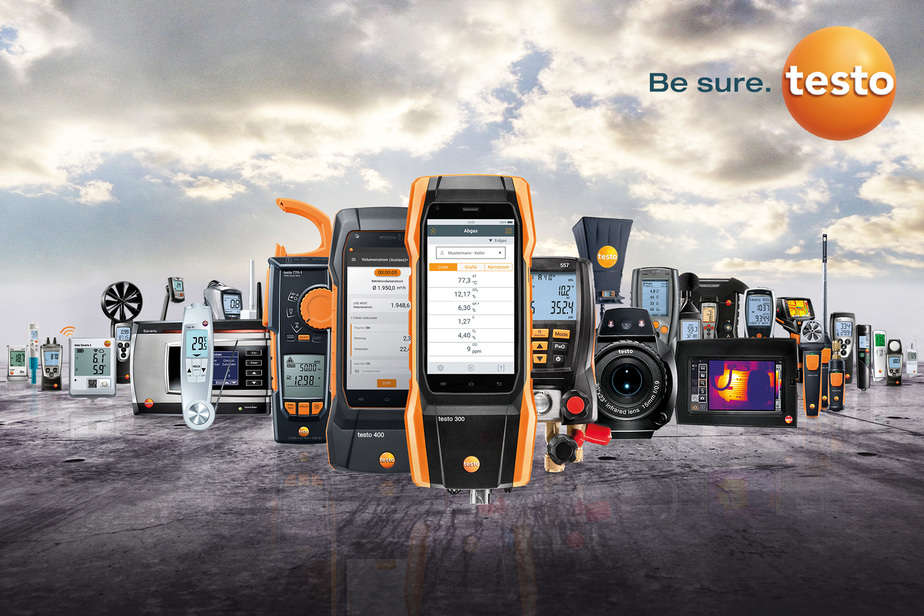
Testo measuring instruments have a long history dating back to 1957, when Paul Linssen and Dr. Karl-Rudolf Rommelfanger formed the company in Germany. At first, the company concentrated on creating and manufacturing electronic measurement devices, mostly for temperature measurement. A vast array of instruments for measuring different factors, including humidity, pressure, airflow, combustion analysis, thermal imaging, and more, have been added to Testo's product line throughout the years.
Let’s categorize testo measuring instruments. Now, remember that these are not all categories and not all products from testo. But this is a great short introduction of testo measuring instruments.
Workspaces
Whether people feel comfortable in the workplace depends on a variety of comfort-related parameters. In addition, there are legal standard values (e.g., for sound level, luminous intensity, and CO₂) that must be adhered to. Testo's smart measuring technology assists you in determining the degree of turbulence, the indoor air quality, and the level of thermal comfort in accordance with PMV/PPD. This allows you to respond to employee complaints using objective values and to monitor compliance with the standard values at any time. The goal is to create an indoor climate where as many people as possible feel comfortable and can work productively.
Universal IAQ instrument
testo 400
With just one instrument, testo 400 is the universal measurement tool for all IAQ specialists, allowing them to measure, record, and evaluate all IAQ parameters.
Air velocity & IAQ measuring instrument
testo 440
The advantages of a small, portable device with intuitive measurement menus and a wide range of air velocity and IAQ probes are combined in the Testo 440 air velocity & IAQ measuring equipment. The Testo 440 can be linked to several Testo temperature probes, the Testo Smart Probes, and a wide range of digital probes.
WiFi data logger system
testo Saveris 2
The most up-to-date method for keeping an eye on the humidity and temperature in workrooms and storerooms is the testo Saveris 2 WiFi data logger system.
Thermohygrometer
testo 608-H2
Hygrometer alarm, temperature, dewpoint, and humidity gauge with LED alert; comes with battery and calibration instructions.
Temperature/humidity data logger
testo 175 H1
Wall bracket, lock, batteries, calibration instructions, and an external humidity sensor (NTC/capacitive humidity sensor) are included with this 2-channel temperature and humidity data logger.
Sound level meter
testo 816-1
A sound level meter, a microphone, wind protection, PC software, a connecting cable, a CD-ROM with the instruction manual, and batteries inside the system case are all included.
CO/CO 2 measuring instrument
testo 315-3
Ambient CO/CO 2 measuring instrument without Bluetooth, includes USB mains unit and cable.
Lux meters
testo 540
Handy lux meter, includes protective cap, calibration protocol and batteries.
HVAC & air conditioning systems
In contemporary buildings, powerful HVAC and air conditioning systems guarantee a comfortable working environment. But these can only function well and trouble-free when they are tuned and maintained on a regular basis.
Insufficiently low air flows fail to dissipate room loads, and excessively high air flows raise operating expenses. Testo's smart air flow meters allow you to precisely and consistently measure turbulent flows at ventilation outlets in addition to allowing you to swiftly and simply verify the air flows in ventilation ducts and at outlets and compare them with the design plan.
VAC kit
Testo Smart Probes
To perform maintenance on air conditioning and ventilation systems. Includes the following: batteries, calibration protocol, testo Smart Case (VAC), testo 405i, testo 410i, testo 605i, testo 805i, and testo smart case.
Thermal anemometer
testo 405
Thermal anemometer with duct bracket, batteries included, and attachment clip.
Vane anemometer
testo 410
Vane anemometer with built-in humidity measurement and NTC air thermometer, includes protective cap, calibration protocol and batteries.
Vane anemometer with App
testo 410i
With smartphone operation, this vane anemometer measures temperature, volume flow, and air velocity. It comes with batteries and calibration protocol.
Vane anemometer
testo 417
Vane anemometer with temperature and vane measurement built in, 100 mm vane, calibration procedure, and battery.
Flow straightener kit
testovent 417
Testovent 417 funnel kit and volume flow straightener are included in the testovent 417 flow straightener kit for volume flow.
Heating systems part 1
Flue gas analyzer
testo 300
With the testo 300 combustion analyzer, heating systems can detect combustion in a truly intelligent way.
Flue gas analyzer
testo 330i
The new Testo 330i flue gas analyzer allows for free of tension, paper, and wobbly probes for flue gas analysis.
Differential pressure measuring instrument
testo 510
Convenient differential pressure measurement device with belt pouch, batteries, protective cap, calibration process, and hose kit (Ø 4 mm and 5 mm) included.
Differential pressure measuring in-strument with smartphone operation
testo 510i
This differential pressure measuring device may be operated with a smartphone and comes with a hose kit (Ø 4 and 5 mm) with an adapter, batteries, and calibration instructions.
Heating kit
Testo Smart Probes
For temperature and pressure readings on heating systems. Includes: Testo 115i, Testo 510i with hose kit (Ø 4 mm and 5 mm) and adapter, Testo 805i, Testo Smart Case (heating), batteries, and calibration methodology with test results.
Pressure and leakage tester
testo 324
High-pressure stage stops ¾" and 1¼", testo easyHeat PC program, manual test pump for creating the test pressure, adapter for the test port on gas boilers, mains unit, system case with feed unit, terminal block* with connecting hose, leakage measurement instrument for all legally required tests.
Pressure measuring instrument
testo 312-4
DVGW-tested differential pressure measuring device with a 200 hPa operating pressure, battery, and calibration instructions.
High-pressure gauge with Smartphone operation
testo 549i
High-pressure measuring instrument with smartphone operation, includes batteries and calibration protocol.
Heating systems part 2
Heat leaks out of windows when a heating system is not set properly. It's also possible that the room won't heat up adequately due to the radiators farther away in the circuit. Here, hydraulic balancing makes sure that the appropriate amount of water is delivered at the appropriate time to the appropriate location. The flow and return temperatures as well as the radiator's heat distribution are the crucial variables for hydraulic balancing.
Clamp thermometer with smartphone operation
testo 115i
For use on pipelines with diameters ranging from 6 to 35 mm, this clamp thermometer with smartphone control comes with batteries and a calibration methodology.
Thermal imager
testo 865
Included are a USB cable, mains unit, lithium-ion rechargeable battery, professional software, brief instructions, calibration methodology, case, and commissioning instructions.
Infrared thermometer with smart-phone operation
testo 805i
Infrared thermometer that works with smartphones; comes with batteries and a calibration protocol.
Temperature measuring instrument
Mini penetration thermometer
Reaching up to 250°C, measuring 213 mm in length, with a probe tube protective casing, an easy-to-read display, batteries included, and a calibration protocol.
Combined infrared/penetration thermometer
testo 104-IR
Waterproof, foldable, infrared penetration thermometer with batteries and calibration instructions.
pH/temperature measuring instrument
testo 206
One-hand pH/°C measuring instrument, protection class IP68, includes storage cap with gel, TopSafe and belt/wall bracket.
Digital multimeter
testo 760
TRMS multimeter with batteries, measurement cable set, and type K thermocouple adapter included.
Refrigeration systems and heat pumps
Air conditioning and refrigeration equipment use a tremendous amount of power. You can reduce costs by optimizing your systems and performing routine maintenance on them. With digital manifolds and custom apps, Testo can help make the commissioning and maintenance of refrigeration systems and heat pumps as accurate and convenient as possible for you. for the smooth, effective running of your systems.
Digital manifold
testo 550
Digital manifold with Bluetooth for refrigeration systems and heat pumps, includes 2 x clamp probes, batteries, case and calibration protocol.
AC & refrigeration test kit
Testo Smart Probes
For air conditioning and refrigeration system maintenance, commissioning, and troubleshooting. Consists of: two testo 115i, two testo 549i, and one testo Smart Case (refrigerator), along with calibration protocol and batteries.
Electronic leak detector for refrigerant
testo 316-3
CFC and HFC (partially and fully halogenated) leak detector with sensor head, carry case, calibration procedure, batteries, and filter included.
Temperature measuring instrument (1-channel)
testo 110
This one-channel NTC temperature measurement device comes with a radio probe that can be connected optionally, an audible alert, a calibration methodology, and batteries.
Electrical installations
Elevated temperatures within electrical systems may suggest the presence of an overload, an upcoming malfunction, or an already-existing problem. You can quickly, accurately, and dependably detect temperature increases in low-, medium-, and high-voltage systems with a Testo smart thermal imager or pyrometer. With the use of infrared measurement equipment, you may identify malfunctioning parts or connections early on and take targeted preventive action.
By doing this, the chance of a fire and expensive system failures are reduced.
Voltage tester
testo 750
Voltage tester including batteries, measuring tip protector and measuring tip caps.
Digital multimeter
testo 760
TRMS multimeter with batteries, measurement cable set, and type K thermocouple adapter included.
Clamp meter
testo 770
TRMS clamp meter with batteries, measurement cable set, and type K thermocouple adapter included.
Infrared thermometer
testo 835
This device measures temperature infrared, has a 4-point laser marking system, records measurement data, and comes with free PC software, batteries, and calibration instructions.
Thermal imager
testo 865
Included are a USB cable, mains unit, lithium-ion rechargeable battery, professional software, brief instructions, calibration methodology, case, and commissioning instructions.
Thermal bridges and building weak spots
You may rapidly, safely, and intuitively detect anomalies and damage to building shells or indoor regions using a Testo py-rometer or smart thermal imager. Materials and components are checked via imaging techniques, based on temperature values, or without any contact or intrusion. This saves you time and effort by locating leaks, thermal bridges, and energy losses without requiring you to expose vast sections of pipe systems and piping, as is the case with other approaches.
Thermal imager
testo 872
Included are a BT/wireless LAN module, USB cable, mains unit, lithium ion rechargeable battery, professional software, three testo ε-markers, brief instructions, calibration process, case, and commissioning instructions.
Thermal imager
testo 885
Professional software, an SD card, a USB cable, a carrying strap, a lens cleaning cloth, the mains unit, a Li-ion rechargeable battery, and a headset are all included in a sturdy case.
Humidity/temperature measuring instrument
testo 635 U-value kit
This humidity and temperature measurement device comes with a USB data cable, PC software, reading memory, calibration methodology, and batteries.
Damp and mould
There are numerous reasons why there can be wet areas and mold, including inadequate ventilation, architectural flaws, aging-related damage to the building shell, trace humidity in building materials, and insufficient drying. Testo provides you with an extensive selection of intelligent tools that enable you to swiftly, precisely, and non-destructively look into the origins of wet patches and mold. Testo's thermal imagers, data loggers, and humidity monitoring devices allow you to detect locations that may be susceptible to mold growth early on, allowing you to take timely corrective action. You can avoid having to do costly and time-consuming renovation work by doing this.
Data logger temperature and humidity
testo 176 H1/H2
With external sensor connections (NTC/capacitive humidity sensor), this 4-channel temperature and humidity data logger comes with a wall mount, lock, battery, and calibration instructions.
Wood/material moisture measuring instrument
testo 606
With an integrated moisture measurement and NTC air thermometer, this portable wood and material moisture measuring device comes with a protective cover, calibration instructions, a belt bag, and batteries.
Material moisture measuring instrument
testo 616
This material moisture measuring equipment comes with a calibration methodology and battery for non-destructive moisture testing of wood and building materials.
Humidity/temperature measuring instrument
testo 635
This humidity and temperature measurement device comes with a USB data cable, PC software, reading memory, calibration methodology, and batteries.
In summary
In short, now you know that testo offers quite a variety of measuring equipment nowadays. It started out as a small company but has expanded greatly.
If you are interested as a professional to try out some of the testo products you are welcomed to do so. You can check out our webstore. We have an ENG version of our store so you can easily order by navigating our English language product line.
That’s all for now.
Happy measuring!
Testo 0554 4172 Testovent 417 Flow Straightener
Testovent 417, a novel volume flow straightener, provides optimal support for measuring flow velocity at swirl outputs. The swirling flow can be redirected by the volume flow straightener into an essentially uniform flow, which can then be accurately measured using vane probes or an anemometer.
The only manufacturer offering a solution to the issue of measuring at swirl outlets equally simply and precisely is Testo. Testovent 417, a novel volume flow straightener, provides optimal support for measuring flow velocity at swirl outputs. The swirling flow can be redirected by the volume flow straightener into an essentially uniform flow, which can then be accurately measured using vane probes or an anemometer. Depending on which direction the swirl affects the vane, measurements at swirl outputs without the volume flow straightener yield lower or higher measurement values.
The optional measuring funnel Testovent 417, optional vane anemometer Testo 417, or the vane probes (Ø 100mm) of Testo 435 and Testo 480 are used in conjunction with the volume flow straightener.
Features:
Improved measurement of volume flow that is not reliant on the direction of swirl
Trustworthy measurements on swirl outlets
Retrofittable flow straightener for Testo funnel sets already in place
Applications:
Systems for air conditioning and ventilation
Technical data
General technical data:Weight 554 g
Dimensions 370 x 190 x 210 mm
Operating temperature 0 to +50 °C
Product-/housing material PA66 + GF30%
Volume flow:
Measuring range 0.1 to +200 m³/h
preferred 0.1 to +100 m³/h
Testo 417 vane anemometer - a quick look
For the easy, quick, and accurate measurement of flow velocity and volume flow at the air intake and outflow vents of air conditioning and ventilation systems, the small 100 mm vane anemometer Testo 417 is the perfect choice. Testing at swirl outlets or adjusting for balanced home ventilation is very simple with the Testo 417 kits, which include a funnel and flow straightener. Configuration, display (including a second screen), storage, and recording of the observed values are handled swiftly and easily because of the connection to the testo Smart App.
Additionally, testo 417 comes in two useful kits: Two measurement funnels for plate outlets and ventilation grilles are included in the Testo 417 kit 1. These cover a variety of outlet sizes and types and are simple to install to the vane.
The testo 417 kit 2 comes with two measurement funnels as well as a volume flow straightener to provide accurate readings even at swirl diffusers.
Down below you can see the main 3 options buying testo 417:
Testo 550i - smallest manifold of all time
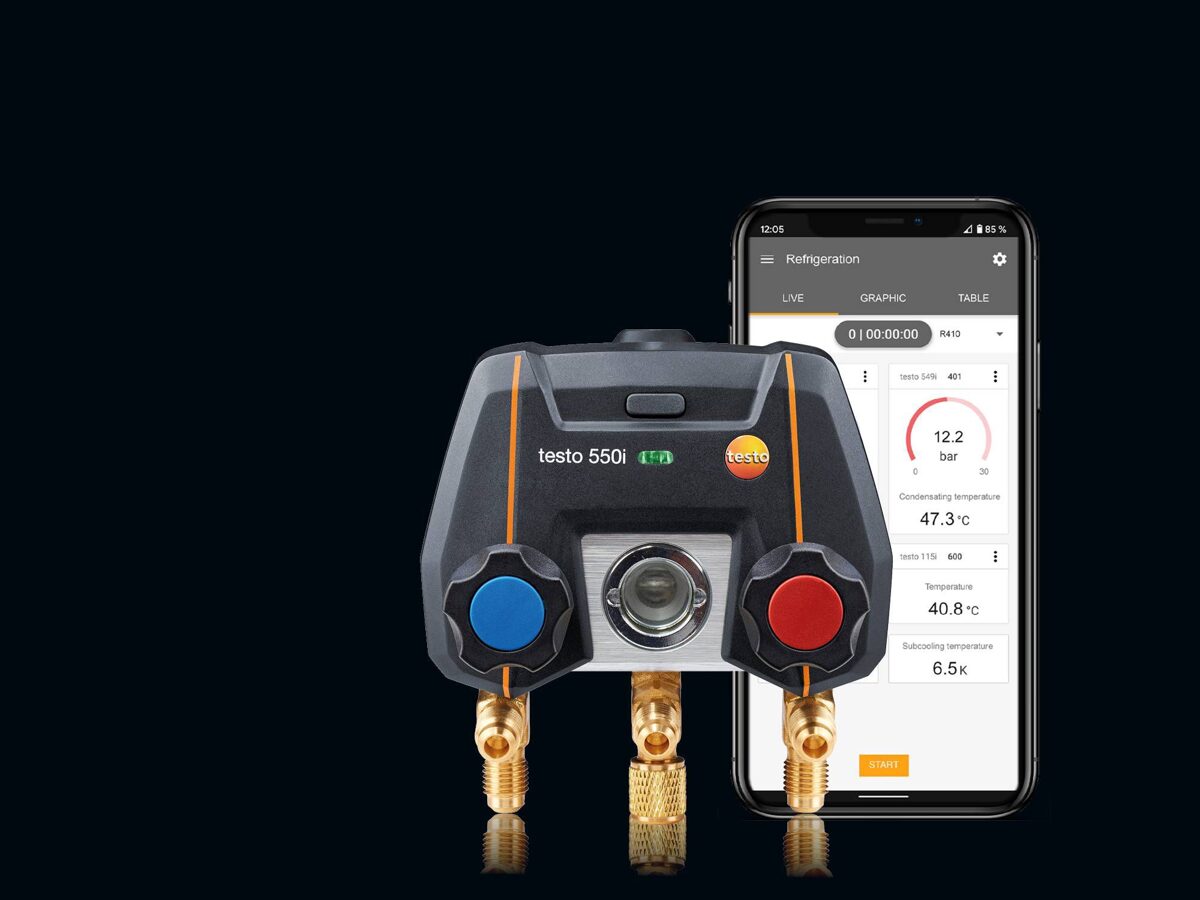 With the first fully digital manifold, the testo 550i, you can use a smartphone, tablet, or the testo Smart App to manage all of the daily service and maintenance you need to do on your heat pumps, air conditioners, and refrigeration systems.
With the first fully digital manifold, the testo 550i, you can use a smartphone, tablet, or the testo Smart App to manage all of the daily service and maintenance you need to do on your heat pumps, air conditioners, and refrigeration systems.
The smallest digital manifold available has a 2-way valve block, handles measurements quickly and easily, and saves a significant amount of time because of the digital documentation.
In addition, the little device pairs with our Bluetooth ® probes for humidity, pressure, and temperature automatically through the testo Smart App. The app has the ability to automatically compute the temperatures of evaporation and condensation. And you're standing calmly to one side, around 150 meters away, holding only your smartphone in your hand.
Bluetooth pairing and the app
No need for wires or cables
Fit for heat pumps, air conditioners, and refrigeration
Features sturdy hook and a two-way valve block
Recognizing probes automatically
Utilizing a tablet or smartphone to control
Sturdy housing
Rated IP 54
Small and minimalistic design
In line with the Testo Smart App
Results that are simple to read
Write expert reports.
Includes a list of preferred refrigerants
Appropriate for Testo Smart Probes
Wirelessly monitor the temperature, humidity, and vacuum.
In line with the Testo DataControl program
Maintain measurement points and client profiles.
These are the applications of Testo 550i: refrigeration systems, air conditioning systems, heat pumps, ductless, single zone, multi zone, mini split systems.
Have a look at the differences between Testo digital manifolds:
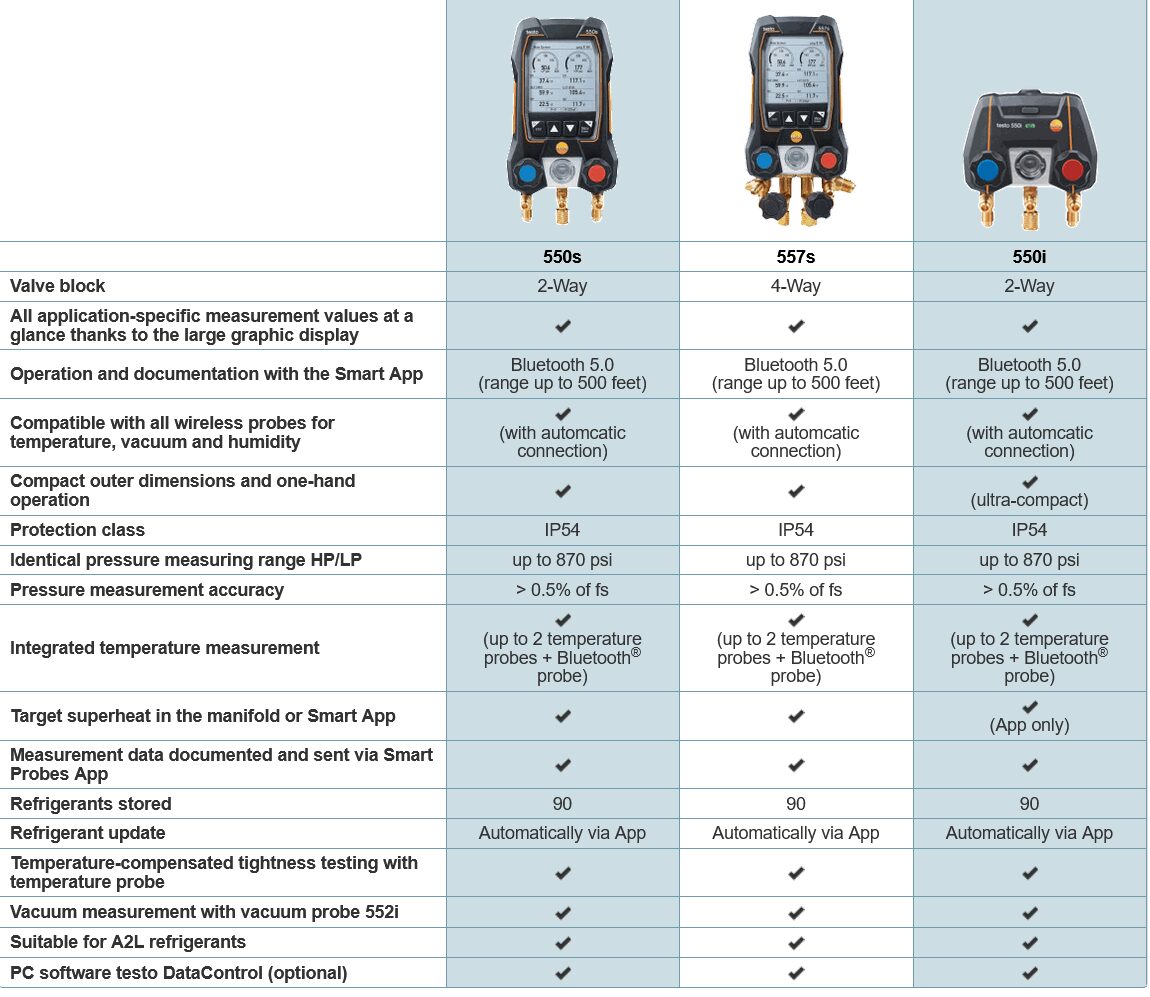
Check out this quick video about the testo 550i digital manifold below.
Testo 550s, 557s and 570s - a buyers guide
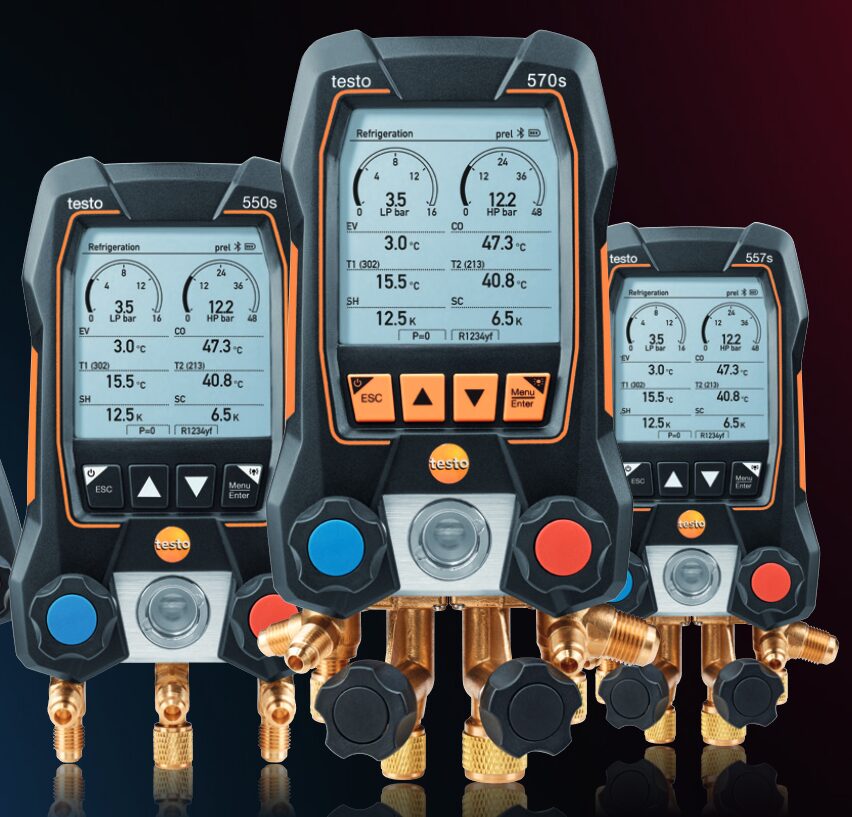 The testo 550s digital manifold boasts a big graphic display, a sturdy, compact housing, guided measurement menus, and the testo Smart App. It also has a 2-way valve block and Bluetooth. For commissioning, service, and maintenance of refrigeration, air conditioning, and heat pump systems, the Testo 550s manifold is a dependable partner thanks to its superior measurement technology, high degree of dependability, and clever functions for rapid, simple measurements and documentation.
The testo 550s digital manifold boasts a big graphic display, a sturdy, compact housing, guided measurement menus, and the testo Smart App. It also has a 2-way valve block and Bluetooth. For commissioning, service, and maintenance of refrigeration, air conditioning, and heat pump systems, the Testo 550s manifold is a dependable partner thanks to its superior measurement technology, high degree of dependability, and clever functions for rapid, simple measurements and documentation.
The Testo 550s refrigeration digital manifold measurement menus will walk you through each measurement mode step-by-step and automatically determine crucial parameters including evacuation, tightness test, pressure drop, and superheat.
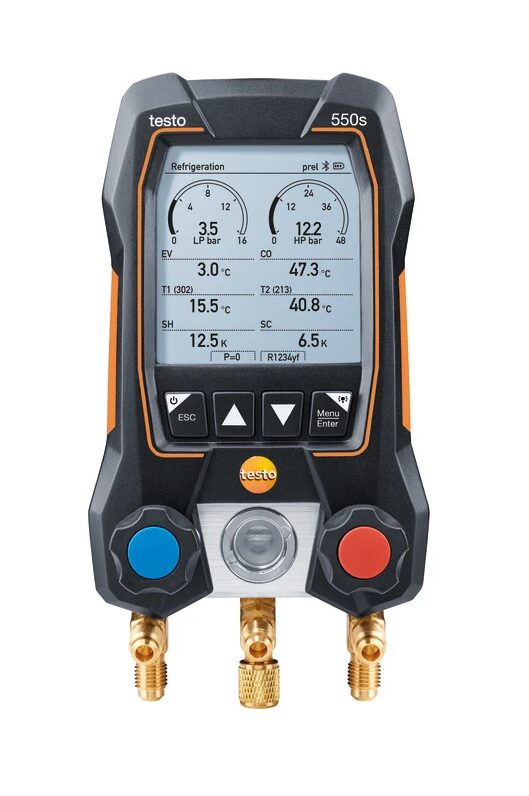 Testo 550s features:
Testo 550s features:
Large visual display to facilitate simple assessment of measurement outcomes
Quick and simple pressure value shown in an analog style
Target superheat is calculated in an integrated manner.
Two clamp temperature probes that are wireless can be bought separately or as a kit
Probe for vacuum without cord (in a kit)
Testo Smart Probes can be used with devices that are Bluetooth enabled.
Menus for guided measurements of goal pressure loss, vacuum, and superheat
90 integrated refrigerants; on-site monitoring and documentation using the Testo Smart App
Refrigerant listing is updated automatically via the app.
The valve block is two-way and has three connections (3 x 7/16"-UNF).
The pressure range is -15 to 870 psi.
Housing IP54
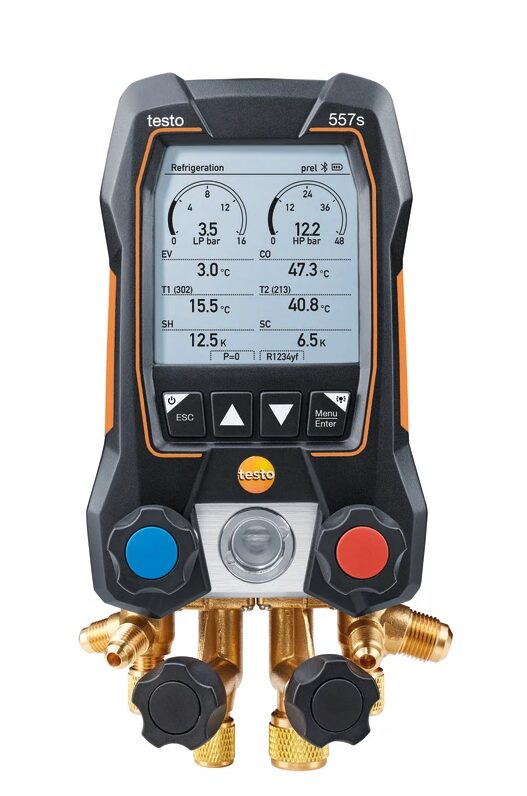 This durable manifold with a four-way valve block makes it simple and quick to measure heat pumps, air conditioners, and refrigeration systems. Furthermore, the expansive display provides a quick overview of all the findings and has wireless temperature probes to detect variations in temperature.
This durable manifold with a four-way valve block makes it simple and quick to measure heat pumps, air conditioners, and refrigeration systems. Furthermore, the expansive display provides a quick overview of all the findings and has wireless temperature probes to detect variations in temperature.
Testo 557s features:
4-way valve block with four connections (three 7/16" UNF and one 5/8" UNF) that operates between -15 and 870 psi
Strong, manageable, and compact housing with IP 54 protection class
External vacuum probe (bought as a kit) for a quicker and more dependable system evacuation
Bluetooth connection for wireless temperature and vacuum measurements that is automatic
Monitors temperatures and pressures on the high and low sides.
Menus for guided measurements of goal pressure loss, vacuum, and superheat
Using the Testo Smart App, on-site monitoring and documentation
Extensive visual aid for assessing outcomes in a graphical format integrated refrigerants
The app's refrigeration management features include automated upgrades and favorites.
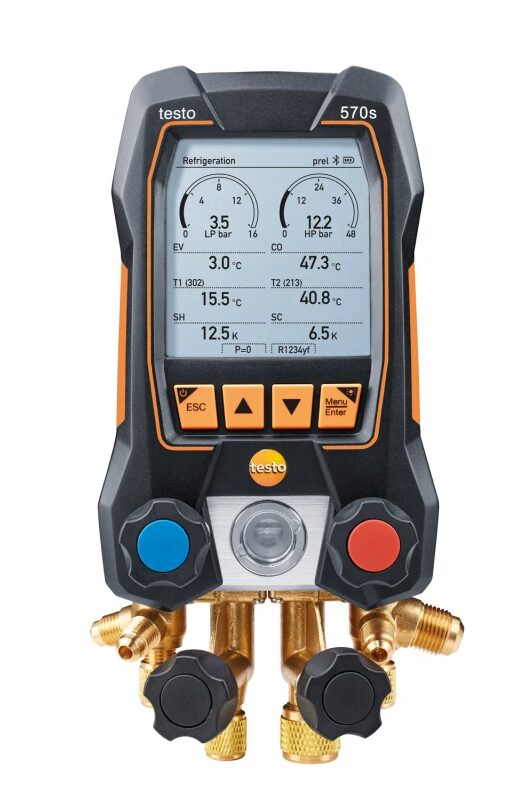
The testo 570s is a digital manifold with Bluetooth and 4-way valve block and intelligent error analysis.
Testo 570s features:
Designed to assess heat pumps and refrigeration and air conditioning systems intelligently over an extended period of time
Long-term monitoring with the Smart App with clever error analysis
Exceptionally extended battery life of up to 360 hours using interchangeable AA batteries and rechargeable batteries (USB-C)
Appropriate for over 90 refrigerants, such as A2L and A3,
Maximum accuracy even at low pressure levels because of 0.25% fs measurement accuracy
On the big screen, view all measurement data at a glance and navigate a graphical progression display.
If you are interested, you can find and buy any of the testo 550s, 557s or 570s digital manifolds at our webstore.
Good measuring and bye!
How to change sensors for testo 340 and testo 350 flue gas analyzers?
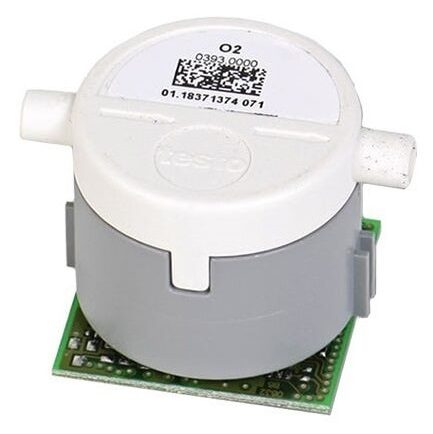 These two flue gas analyzers offer the option to change the pre-calibrated testo sensors yourself.
These two flue gas analyzers offer the option to change the pre-calibrated testo sensors yourself.
We offer you the testo o2 oxygen sensor - 0393 0000 which you can buy from our online store.
Actually the process is very simple and straightforward.
Although here we are showing you how to change the CO sensor, it's very similar to changing an o2 sensor.
Here's how to change the CO sensor step by step:
1.) Switch off the 340 or 350 by testo.
2.) Unplug from the main supply.
3.) Loosen the two screws from the back of the device. Remove the service lid.
4.) To replace a sensor, the hoses must be disconnected from the sensor. Pull out upwards the sensor.
5.) Replace the old sensor with the new one. The new filter needs to be replaced with the old.
6.) Remember - don't touch the sensor electronics or bottom of it. The pins on the bottom ensure that everything is connected correctly.
7.) Then plug back in the sensor for testo 340 or 350. Reconnect the hoses.
8.) Place back on the service cover and tighten the two screws.
That's all.
When you've done the 8 steps previously, then the testo 340 or 350 can be used immediately.
Here's a quick video showing how to change CO sensor for Testo 340.
https://www.testo.com/en-VN/videos/video-application-emission-sensor-replacement
Ready to change yourself the o2 oxygen sensor?
It's easy.
0393 0000 can be purchased from our online shop.
To do that, go to this link.
Buy 0393 0000 replacement o2 sensor.
Happy measuring!
Good day!
Testo 0563 3105 (310 II Flue gas analyzer) - what new features?
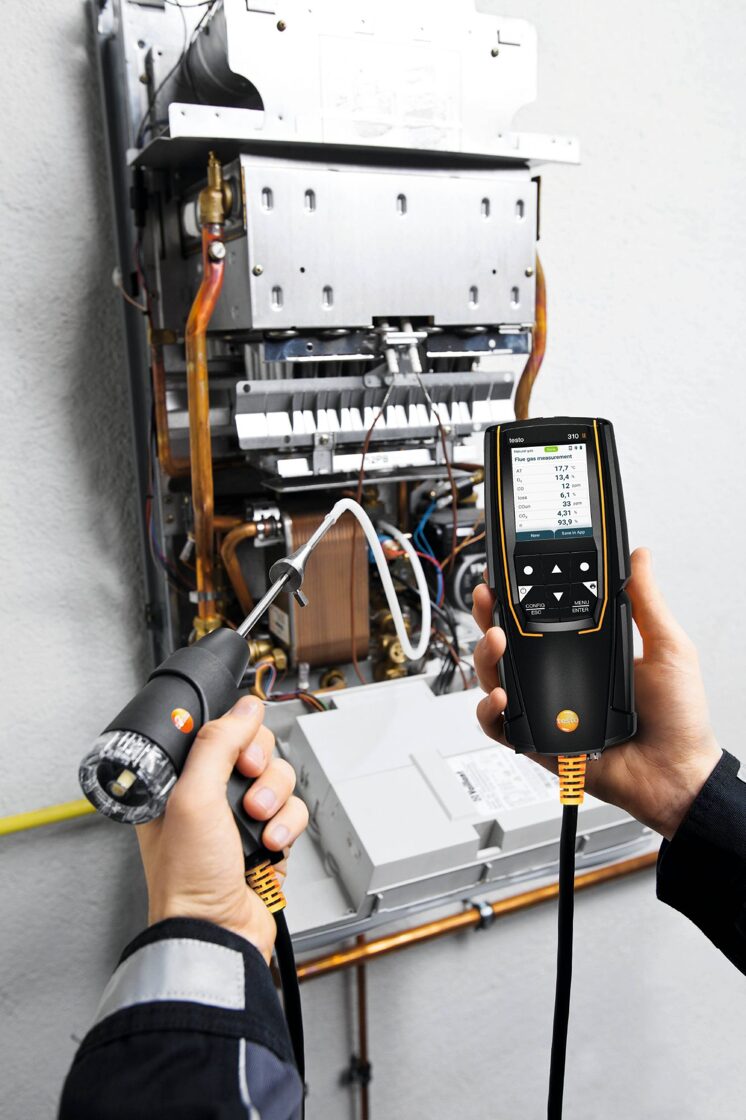
Let's take a look at some of the new features of the Testo 0563 3105 flue gas analyzer 310 II.
But first, what remains the same?
Well, it still comes with the hard case. When you open it, it still looks very similar to the older 310 generation one.
Next, the probe is still permanently attached to the bottom of the instrument.
Next, it has got the silicon hose.
Then, you've got the 5 particle filters.
Also a flue pipe adapter and a USB-C cable. And lastly - a power supply and cable.
Okay, that's that.
But what about new features?
Here they are:
Number #1: A new larger full color display. It gives enhanced visibility.
Number #2: Bluetooth connectivity. The chance to connect to smartphone and use it as a second display. You now have the possibility to read measurements there.
You can save the readings, do graphing and customize reports.
Number #3: Included is a quick-start guide.
Number #4: Certificates of conformance and calibration.
Number #5: A new Bluetooth printer to print measured documents.
Number #6: Magnets for easy attachment to burner.
All in all, that's it.
You can buy the instrument from our online shop. Please click the button below!
Buy the Testo 0563 3105 flue gas analyzer - click here!
Happy measuring!
Good day!
New Testo 310 II Flue gas analyser - a basic overview
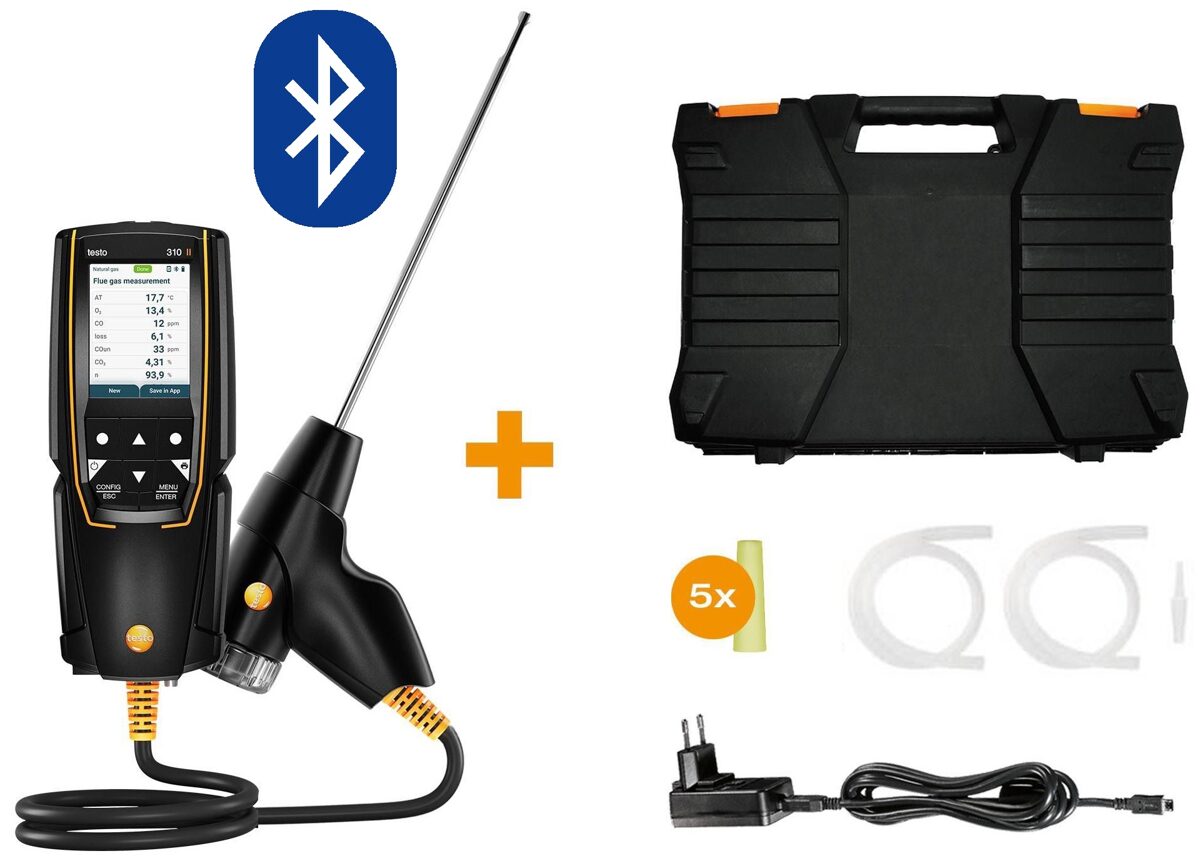 Fairly recently Testo introduced the world to the new Testo 310 II Flue gas analyzer.
Fairly recently Testo introduced the world to the new Testo 310 II Flue gas analyzer.
Let's take a quick look at this instrument.
The straightforward and user-friendly guiding menu of this combustion analyzer makes it easy to monitor and show all measurement parameters (O2, CO, CO2, flue gas, ambient temperature, CO environment, draught, and pressure) simultaneously and individually. The analyzer is always prepared thanks to its long battery life, which exceeds eight hours. The Testo Smart App makes it simple to configure the analyzer as well. This gas analyzer's compact size and easy handling make it a reliable tool for everyday work, even in challenging situations.
Features:
Simple and clear menu instructions
Measurements of O2, CO2, CO, HPA/"H2O, QA, and °F/°C
Individual measurements taken simultaneously using the Testo Smart App for return temperature, flow, and gas flow pressure.
Documented data transmitted digitally through the Testo Smart App
Utilizing the Testo Smart App Sensor zeroing in 30 seconds for digital client data management
Easily customizable display: a seven-line screen with an intuitive menu system. Simple to use and easily readable (display programmable using the testo Smart App)
Sturdy and lightweight device ideal for regular usage, especially in unclean and rugged environments
Sensor zeroing automatically: Within 30 seconds of startup, the gas sensor automatically zeros; this can be stopped if not needed.
Lithium battery that can be recharged: Rechargeable lithium battery (1500 mAh) operation: no need to replace the battery, up to eight hours of runtime, and USB charging
The condensate trap Condensate trap integrated; quick and simple to empty
Magnets included into the burner allow for simple installation.
Probe filter: Exchangeable quickly and effortlessly
Uses:
- HVAC/R
- Industrial manufacturing
- Power plants
- The automotive sector
- Environmental surveillance
- Inspection of residential and commercial buildings
- Upkeep and servicing of boilers
- Inspections for safety
If you need to buy the Testo 310 II Flue gas analyzer, then you can do it at our webstore here - Testo 310 II flue gas analyzer.
As always, happy measuring!
Good day!
Hanna Instruments pH testers - bad practices to avoid
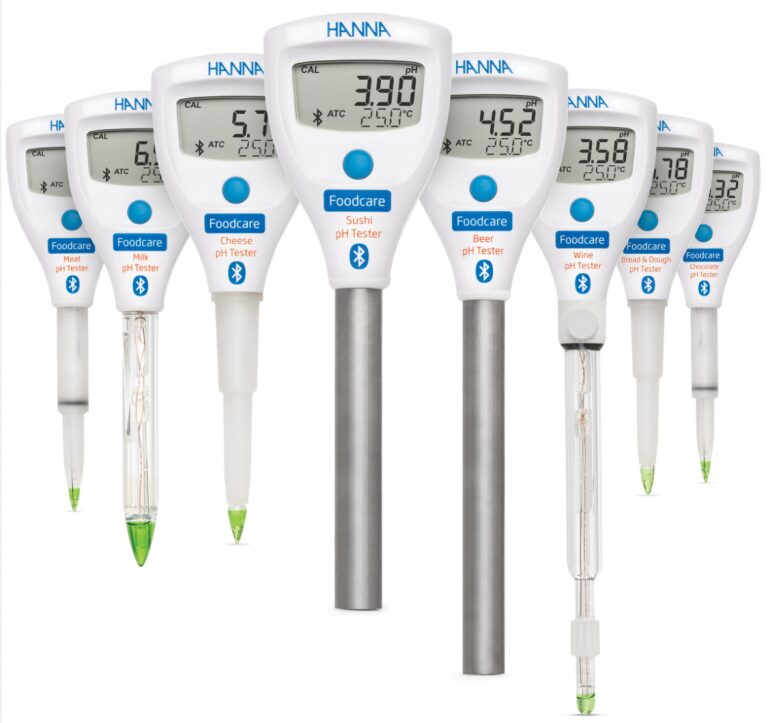
It’s not enough to simply buy and use the pH tester as you want. There are some good and bad practices on how to use and maintain a Hanna Instruments pH tester.
But don’t worry. The usage and maintenance parts are not so difficult. Any logical person can do it.Let’s now talk about the bad practices:
1. Keeping the electrode away from moisture
Three distinct glass layers make up the detecting glass of a pH electrode: an inner, hydrated layer, and an outside, hydrated glass gel layer. The electrode's sensitivity to pH variations is provided by the hydrated layers; if the electrode is dried out, its sensitivity is significantly diminished.
Inaccurate readings, sluggish reaction times, and shifting pH levels result from this. Fortunately, by immersing the bulb and junction in a pH storage solution for at least one hour, you can usually restore a dried-out electrode. You can then calibrate the electrode and resume testing after that.
2.Cleaning the detecting glass
Your meter receives a voltage from an electrode that is dependent on the pH of the sample it is immersed in. Cleaning the pH glass may result in a static charge that taints the electrode's voltage readout. The pH value that the voltage is regarded as is also thrown off when the voltage readout is incorrect. Furthermore, the hydrated layer of glass that you have diligently developed through appropriate storage is disrupted.
Just clean the electrode with deionized or distilled water rather than wiping the electrode sensing glass.
3.Electrode storage in deionized water
Another common error made while keeping your pH electrode is to use pure water (such as deionized, distilled, or reverse osmosis).
There are almost no ions in deionized water, but there are plenty of ions in the pH electrode—both in the hydrated part of the pH sensor glass and the filling solution. The ions in an electrode will try to migrate out into the solution when it is submerged in an ion-free solution in an effort to create equilibrium. Most of the ions will eventually leave the electrode, making it ineffective. Additionally, the glass will break down far more quickly, resulting in shorter electrode lifespans.
Remove any electrode you come across that is kept in distilled or deionized water right away. Replace the fill solution if the electrode can be filled again. After changing the fill solution, calibrate and store the electrode in the storage solution.
4.Failing to clean the electrode
Accurate pH measurements can only be obtained by cleaning in addition to calibrating. This occurs as a result of deposits coating the detecting glass on the electrode. Consequently, you will not be measuring the sample alone, but the deposits as well.
Unclean electrodes might also result in a delayed response time. Even if the value seems fixed, it's actually drifting very slowly to the true value; you might even record it at that point. There could be an extremely tiny layer of scale or grease on the electrode, even if it looks clean.
5.Utilizing a worn-out or expired electrode
The glass's sensor part will deteriorate and lose some of its original responsiveness as electrodes age. Your electrode will eventually cease reacting appropriately to pH variations.
When electrodes are operating correctly, there are specific numbers connected to them. Two well-known measures that you can use to gauge the performance of your electrode are slope and offset. It is possible to ascertain these figures during calibration.
Sometimes, no matter how hard you try, the electrode just doesn't work the way you want it to. It may be time to replace the electrode if it is old.
Okay.
Now that you know some of the bad practices, are you ready to take your pH testing game to the next level?
It’s easy really.
If you need, you can buy your own Hanna Instruments pH tester (from a wide selection) from our web store here - Hanna pH testers!
Good measuring and good day!
Testo 560i vs Fieldpiece SR47 wireless refrigerant scale
Which one is better - the Testo 560i or Fieldpiece SR47? Let’s find out today!
Both are wireless refrigerant scales used for residential or commercial HVAC/R technicians to charge and recover refrigerant efficiently and accurately.
 Let’s look at some of the features of Testo 560i digital refrigerant scale:
Let’s look at some of the features of Testo 560i digital refrigerant scale:
This device offers high-precision measurements with a resolution of 10 g and outputs the readings in kg
It can handle a maximum load of 100 kg for all common refrigerant containers
The Bluetooth connectivity works flawlessly up to a distance of 30 meters
It also features fully automatic charging as per the set target value
The device has 3D corners for accurate positioning of the refrigerant container and a textured rubber surface for a stable grip, making it safe to handle
It is highly robust with dust and splash water protection (IP44)
The compact housing, low weight, practical carrying handle, and sturdy shoulder bag make it especially handy
The device has a long battery life of up to 70 hours, thanks to replaceable AA batteries and an auto power-off function
It is highly flexible for outdoor use and can operate in temperatures ranging from -10 to 50°C
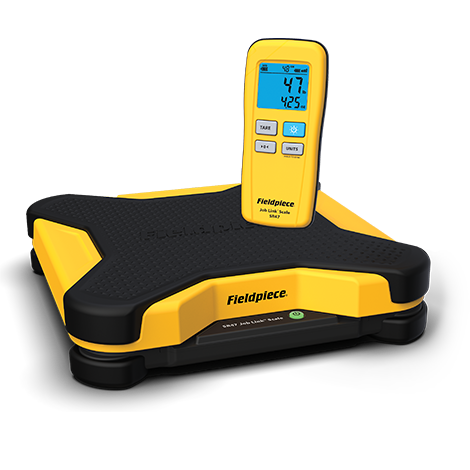 Now, here are the features of Fieldpiece SR47:
Now, here are the features of Fieldpiece SR47:
This scale has a 13-inch platform that can accommodate larger tanks and is equipped with integrated bumpers for increased durability
The scale is strong enough to hold a maximum load of 252 lbs and is lightweight, with a total weight of ~7 lbs
It has a wireless remote control with LED backlight, which can be stored inside the scale, making it easy to view data
The scale has industry-leading accuracy with a tolerance of ±0.03%rdg + 0.25 oz, and it is water-resistant, making it suitable for any job site
This scale connects to the Job Link® System App with a 1000' wireless range and Digital Manifolds SM480V & SM380V
Its platform battery can last for more than 200 hours, which means it can work all week if needed
The scale has an A2L compatibility and automatic power-off (APO) feature after 30 minutes of no activity
The remote can be stored in the base of the scale, and the raised power button is located at the base of the scale for ease of use
The platform is IP54 rated, while the remote is IP64 rated
I will tell you upfront that Testo 560i is more popular overall around the world while Fieldpiece SR47 is mostly popular in the United States. Testo often uses the metric system (also imperial) but Fieldpiece - the imperial system.
Yes, you can set the devices to different measurement systems so you don’t need to worry much.
What are the benefits when you buy the Testo 560i: more established brand; known for selling very high-quality products; trusted by experts; it is slightly cheaper.
What are the benefits of Fieldpiece SR47: offering fresh perspectives for HVAC/R; continuously introducing cutting-edge products; durability and enhanced functionality.
What’s included with Testo 560i:
Digital refrigerant scale
4 x AA batteries
Shoulder bag
Instruction manual
2-year warranty
What’s included with Fieldpiece SR47:
SR47 wireless refrigerant scale platform
Wireless remote
(1) 9V Battery (remote)
(6) AA Batteries (platform)
Carrying case
User manual
1-year warranty
Now it’s time for you to choose the best product for your needs.
Both refrigerant scales have their benefits and drawbacks. Both have quality but the Fieldpiece SR47 is more expensive. Better than the Testo 560i? Not necessarily.
Okay, here’s the deal.
We don’t sell the Fieldpiece SR47 but if you want the Testo 560i wireless refrigerant scale then you can easily buy it from our webstore - click here to buy Testo 560i.
Happy measuring!
Good day!
Overview of HI981030 Soil pH tester
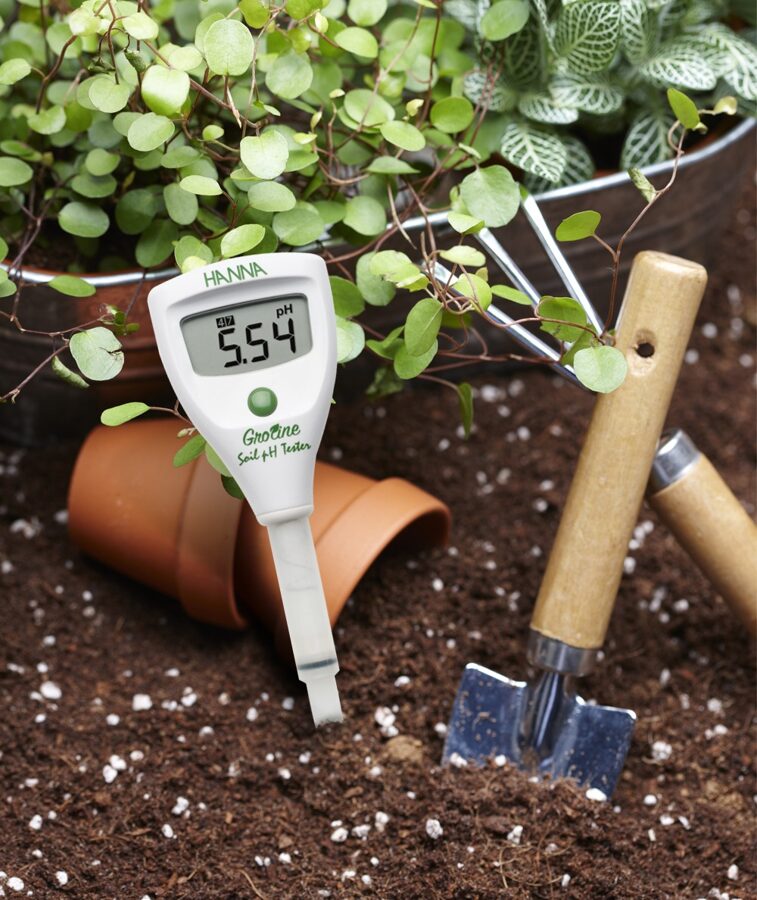
Hanna Instruments GroLine HI981030 pH soil tester is a pH measuring device to check the pH levels in soil.
Here are the specs:
- Built-in cone-shaped pH electrode, specially designed for pH measurements in soil, as well as in soil liquid.
- Removable electrode cover for easy and quick cleaning, ideal for measuring pH levels in soil and soil fluid.
- Polyvinylidene fluoride body, resistant to chemicals and solutions used to disinfect the device.
- One or two point calibration.
- Liquid Crystal Display
- On/off button
- pH probe with maximum and recommended immersion level
It is a quality instrument made to bring simplicity to pH testing of soil. Also, this device is part of the lineup of many other successful pH measuring tools from Hanna Instruments.
There are many features of HI981030. Here are some:
In-built auto-off feature saves battery life for peace-of-mind and energy savings if the meter is accidentally left on.
Pocket size dimensions of the instrument ensures you can do on-the-go testing whenever you need it.
Included is a CR2032 Li-ion battery which provides up to 1000 hours of continuous use.
Readings become slow? Easily remove the sleeve for quick cleaning and new electrolyte. Make sure your probe is clean with a fresh reference electrolyte and it will improve the performance and extend the life of the tester.
The conical shaped tip design allows for penetration into soil and soil slurries.
The HI981030 Soil pH Tester comes with a cleaning solution that has been made to keep your electrode free from organic materials found in soil. Now you can be assured the tester performs in optimum condition.
When performing a pH calibration it is important that the correct buffers are used. Therefore included are some start buffers to get you going. The single-use sachets are individually sealed so you use a fresh buffer each time you calibrate.
We are sure you will love this pH tester from Hanna Instruments.
It’s not so easy to find a great quality/ value pH tester but when you use the HI-981030 you will see that it is all you will need to test soil.
That’s all for now!
Remember, you can buy the HI981030 Soil pH tester here!
Good measuring!
What to look for when buying a paint thickness gauge
A paint thickness gauge is an essential tool to check whether the car you want to buy has been damaged in the past. This tool is particularly useful if you want to buy a used car because a used car has more potential to be damaged in its history.
While others may view car paint as simply cosmetic, we understand its true importance. A good gauge goes beyond aesthetics, providing you with valuable insights into the quality and durability of the paint on any vehicle. Unveil the true story behind every coat of paint and make informed decisions when buying or maintaining your car. Trust in a paint thickness gauge as a reliable tool to uncover what lies beneath the surface.
Paint thickness gauge - what is it?
A car paint thickness gauge, also known as a paint meter, is a device that allows you to measure the thickness of the paint or coating on your vehicle’s surface.
Car lovers or professionals can use it to detect repainted areas of a car.
Main measurements are in microns (µm – one millionth of a meter).
Basically, a paint thickness gauge will allow us to tell whether a car has been repaired.
Three types of paint meters
There are three main types of paint meters. The devices can be equipped with a flat, pressure or ball probe.
First, a flat probe is a basic sensor that is installed in more inexpensive paint thickness meters. It must be pressed precisely against the surface to be checked to obtain the result.
Second, a more refined solution is a paint tester with a pressure probe. It ends with a sensor that hides in the housing when pressed against the bodywork.
Third type is a paint tester with a ball probe. It provides the most accurate measurement results. It can be used to check the coating thickness on convex and concave surfaces, and not only on flat surfaces, as is the case with less advanced probes.
What is a good and “bad” paint thickness gauge?
When choosing a paint meter, opt for one that goes beyond the basics. Look for a gauge that not only detects steel and galvanized steel bodies but also aluminum bodies. Don't compromise on accuracy - go for a tester with a resolution of 1 μm, so you know exactly how thick that paint is.
And let's not forget about the probe. The type and mounting method matter! The best paint thickness gauges feature a ball probe, ensuring accurate measurements and hassle-free usage.
How to use/ check the paint thickness with a paint meter?
Know what to expect with typical paint thickness ranges, but beware of variations based on country of production or vehicle brand. Japanese or South Korean models may have thinner coatings compared to European cars, so don't be surprised by a result of 100 μm. But keep an eye out for discrepancies that exceed 40% - this could indicate a repainted part.
Don't let shady repairs go unnoticed. If your meter shows results exceeding 200-300 μm or if there's a stark difference in paint thickness between opposite sides of the vehicle, it's time to question the integrity of that paint job.
How to use a paint thickness gauge? Make sure that the car is clean. While a ball probe tester can handle dirt, a basic meter may show false results.
Place the probe perpendicularly on the car body and press lightly. You need to check the entire body of the car and the order in which items are checked does not matter much. For example, you can start with the roof, because it is an element that is relatively rarely painted.
Then you can work around the whole body of the car with the paint meter to check every essential part.
Remember, we check a given car element in several or even a dozen places. For example, we examine the door not only in the middle, but also on the pillar, upper and lower edges, and in the front and rear parts.
When is it useful to exploit a paint meter?
For example, if you’re buying a used car and are not sure about its history, you may want to measure the paint level on different body parts. Again, higher readings can signal a repaint, meaning that the car was involved in some accident or the metals were rusty.
Another case is for car detailers. Very often car detailing involves cosmetic work, so it is important to know the paint levels before doing any corrections. It will allow you or auto detailers to determine if the car’s surface contains enough clear coat to do modifications safely.
Finally, it’s beneficial to check the quality of the paint job after it’s done. With a paint meter we can easily do that. Simply use it to check panels, etc.
Where to buy a paint thickness gauge?
You can easily buy one from our webstore.
Here is the list of paint thickness meters you can buy - click here!
Difference between Gann Hydromette Compact series models
Discover the power of precision with the Gann Hydromette Compact moisture meter.
Designed to be your trusty companion in determining water content, this high-quality yet affordable device utilizes advanced technologies such as resistive, capacitive, and infrared measurement methods.
Whether you're a DIY enthusiast or a professional in need of occasional use, the sleek black Compact series is here to provide you with accurate readings and peace of mind. Don't compromise on quality - choose Gann Hydromette Compact for all your moisture measurement needs.
Let’s take a quick look at each of the Gann moisture meters.
1. Gann Hydromette Compact
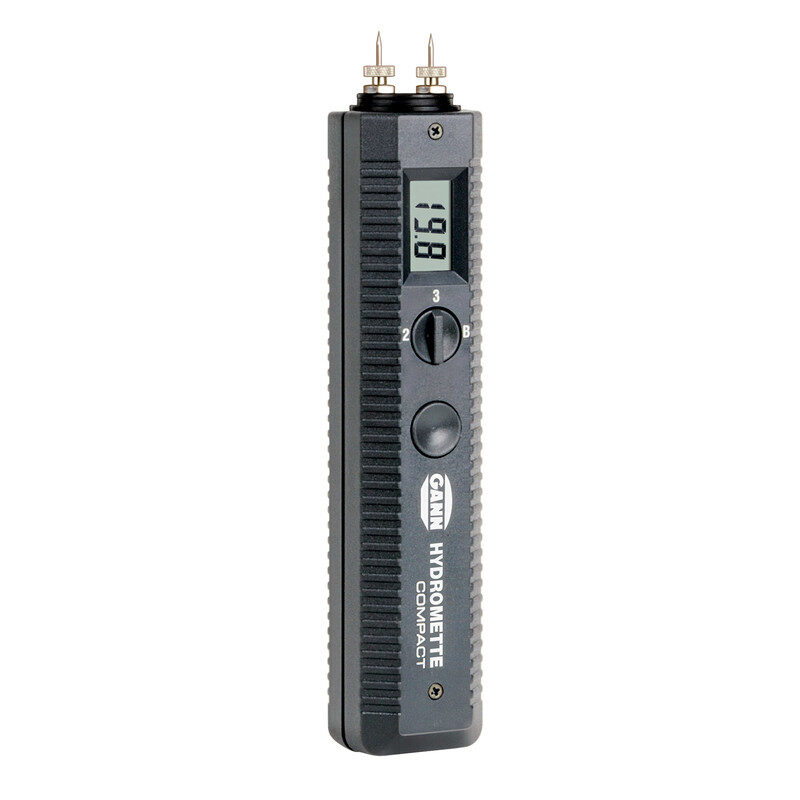
The Gann Hydromette Compact is an electronic wood and plaster moisture meter based on the resistance measuring principle.
With its innovative resistance method and contact electrodes (needles), you can effortlessly determine the moisture content of various wood species, plaster, and even plaster up to 25mm thick. Whether you're a professional carpenter or a DIY enthusiast, this insertable material moisture meter is a must-have tool for ensuring optimal quality and preventing costly damages. Trust the Gann Hydromette Compact to provide reliable readings and make your projects a breeze!
You can buy the Gann Hydromette Compact from our webstore - click here!
2.Gann Hydromette Compact S

Whether you're a professional or a DIY enthusiast, this electronic wood moisture meter is designed to make your life easier. With mean value calibration for both softwood and hardwood, you can trust the accuracy of your readings. The large 3-digit LCD display ensures clear visibility, while the measuring tips allow measurements in wood up to 30mm thick. Say goodbye to guesswork and hello to reliable results with the Gann Hydromette Compact S.
Please visit this link to buy Gann Hydromette Compact S - click here!
3.Gann Hydromette Compact A
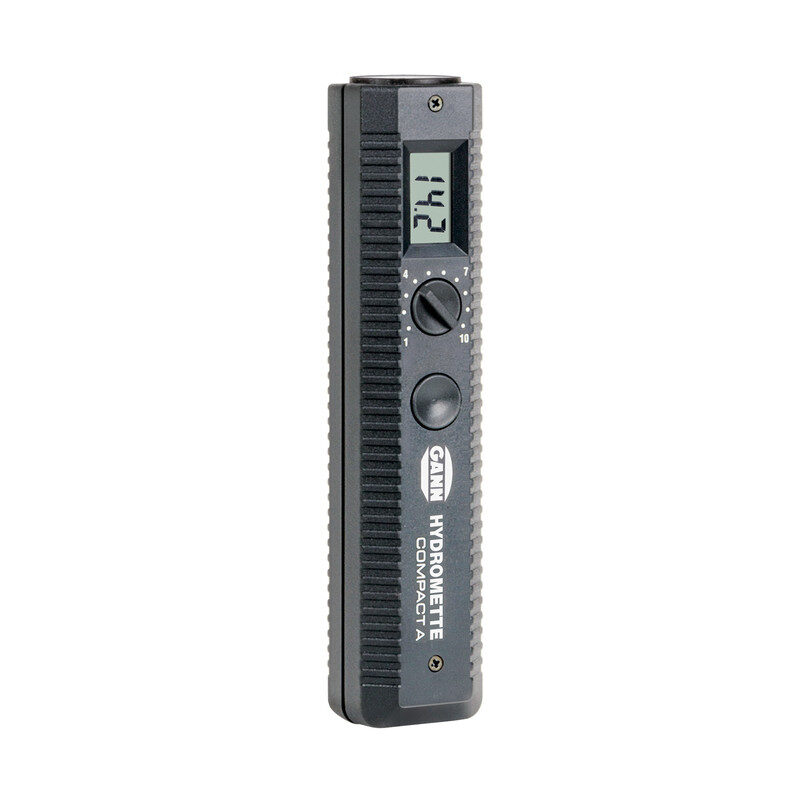
This is the secret weapon that professionals in the painting, interior decorating, parquet laying, and cabinet making industries swear by - the Gann Hydromette Compact A. This compact moisture meter is designed to give you quick and accurate readings, ensuring your projects are flawlessly executed every time. Say goodbye to guesswork and hello to precision with this handy tool that fits right in your pocket. Elevate your craftsmanship with the Gann Hydromette Compact A - the ultimate companion for perfectionists like you.
Mounted wood moisture meter, which does not damage the material during measurement, with the option of choosing between 10 different wood species or material density characteristic curves.
To buy Gann Hydromette Compact A - please click here!
4.Gann Hydromette Compact B
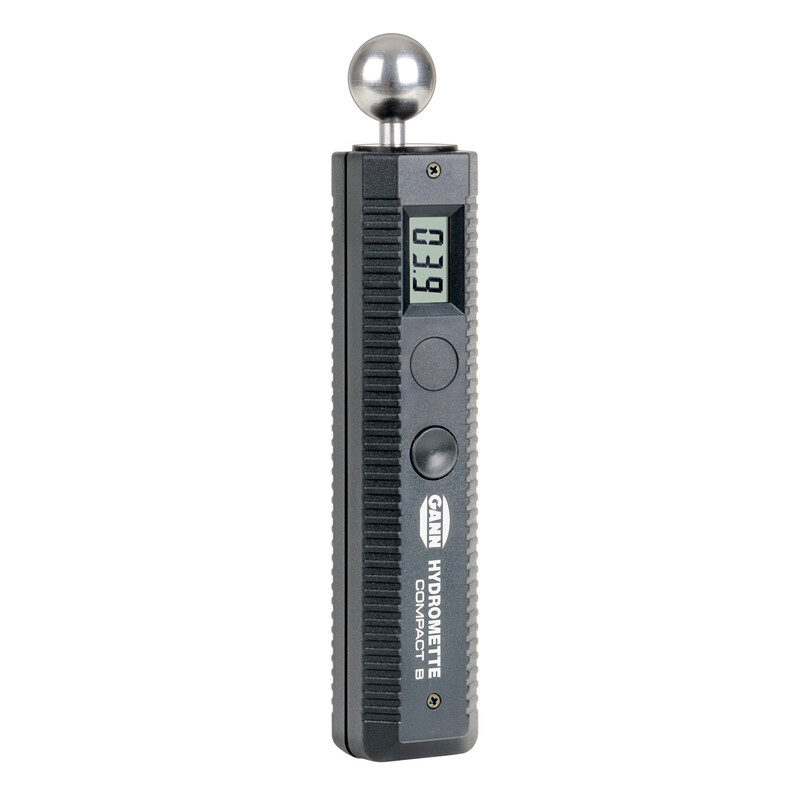
The Gann Hydromette Compact B is the ultimate solution for accurate and non-destructive moisture measurement in building materials. With its removable ball sensor, you can effortlessly detect moisture levels without causing any damage to the surface. Our patented technology, based on the dielectric constant/high frequency measurement principle, ensures precise readings every time. Stay ahead of potential moisture-related issues with this mounted moisture meter, trusted by professionals for its reliability and ease of use.
Gann Hydromette Compact B is located in our webstore here for purchase!
As you now can see, each of the 4 Gann Hydromette Compact series models is slightly different.
Each offers some different features and benefits but every one of them is a great tool to measure moisture in different materials.
That’s all for this review.
Please find the model you need from our webstore here - click here!
Happy measuring!
Testo 535 - FAQ about CO2 measuring
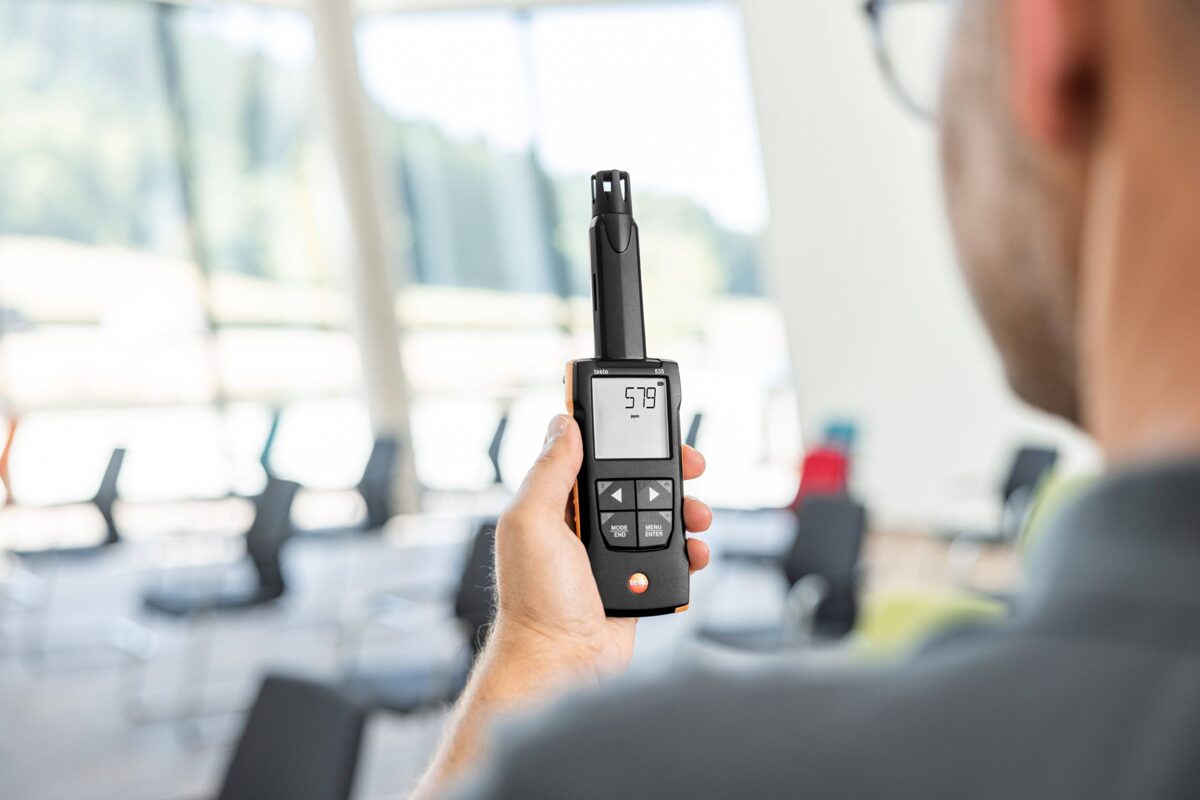
Testo 535 is ideal for ensuring the air quality is optimal for humans to breathe. For example, if carbon dioxide is high in a room then it can cause many health complications like fatigue, headaches and even fatality.
Let’s talk about frequently asked questions people might ask related to CO2 monitors and devices like the Testo 535.
1.How does the Testo 535 work?
It uses a CO2 infrared sensor to measure CO2 in air. The measuring device then displays the CO2 levels in parts per million (ppm) on a digital screen or through the Smart App as a second display.
2.What is considered an optimal CO2 level in air?
Of course, this is a debatable question (because every person is slightly different) but universally optimal CO2 level is generally considered to be between 400 and 1,000 ppm for indoor environments. Though, keeping the levels below 800 ppm is recommended by some experts.
3.Is CO2 dangerous or not?
Generally speaking, CO2 is not toxic but it is definitely very harmful for humans in high concentrations in closed environments.
For example, CO2 above 5,000 parts per million (ppm) can cause symptoms such as headache, dizziness, and shortness of breath. When CO2 concentrations are very high (like above 40,000 ppm) that can cause unconsciousness and even death.
4.What affects CO2 levels in air?
In general, CO2 levels tend to increase in poorly ventilated, crowded, or small spaces.
The factors that can affect CO2 levels also include the activities performed in the room (e.g., cooking, exercising, smoking), and the outdoor air quality too.
5.How to stay healthy around CO2?
It is important for the indoor spaces to be well-ventilated where CO2 exists.
Also, it is recommended to use a device like Testo 535 to measure CO2 levels. You can purchase one of these from our webstore here - click here!
6. Why buy Testo 535 over other similar CO2 measuring devices?
Here are some of the benefits of the Testo 535 measuring instrument:
Simple, fast, and precise measurement of CO2 concentration
Audible alarm sounds if a limit value is exceeded
Fast in-app configuration, graph history, second screen and measurement data memory in the Smart App
High reproducibility of measurement results due to long-term stable infrared sensor technology
Timed and multi-point mean calculation
Again, to buy Testo 535, please visit our webstore here - click here!
How to use the testo 560i?
Testo 560i scale with intelligent valve and manifold (for example, testo 557s) make refrigerant charging a breeze. And you can see measurements and everything clearly on your smartphone too.
Why would you need this device? Well, for example the refrigerant in the system could be too low.
The beauty of the testo 560i kit is that it’s wireless using Bluetooth.
Make sure everything is connected correctly to the system.
Below you can see a graphic on how to connect the tools.
Second step is to switch on the scale, valve and manifold you have at hand. Then also start Smart App and make sure Bluetooth is switched on.
Third, select charging program according to target value:
-weight
-superheat
-subcooling
-target superheat
Fourth, enter a target value, for example, 3 lbs as target weight.
Fifth, scale, valve, manifold and Smart App do the rest for you.
That’s in short how you do it.
If you want a more thorough explanation and demo, please watch this video below:
https://www.youtube.com/watch?v=_oGIZ9gd_VE
The video will explain how easy it is to use testo 560i with intelligent valve and manifold for charging of refrigeration or air conditioning system, or heat pump.
As a tool for HVAC professionals the testo 560i is very useful, as you now can see.
Here are some of the other benefits of 560i:
-wireless measurement of the refrigerant weight
-automatic and accurate refrigerant charging according to target value with the Intelligent Valve
-operation by testo smart digital manifolds and testo Smart App via Bluetooth
-all measured values at a glance on testo smart digital manifolds or testo Smart App
-especially handy thanks to compact housing, low weight, practical carrying handle and sturdy shoulder bag
-compatible with testo smart digital manifolds, testo Smart Probes and testo Smart App
If you are ready to take your HVAC game to the next level with German engineered testo smart devices, then please check out our webstore here to buy a Testo 560i kit - click here!
Testo 0390 0070 - a short guide and how to replace it
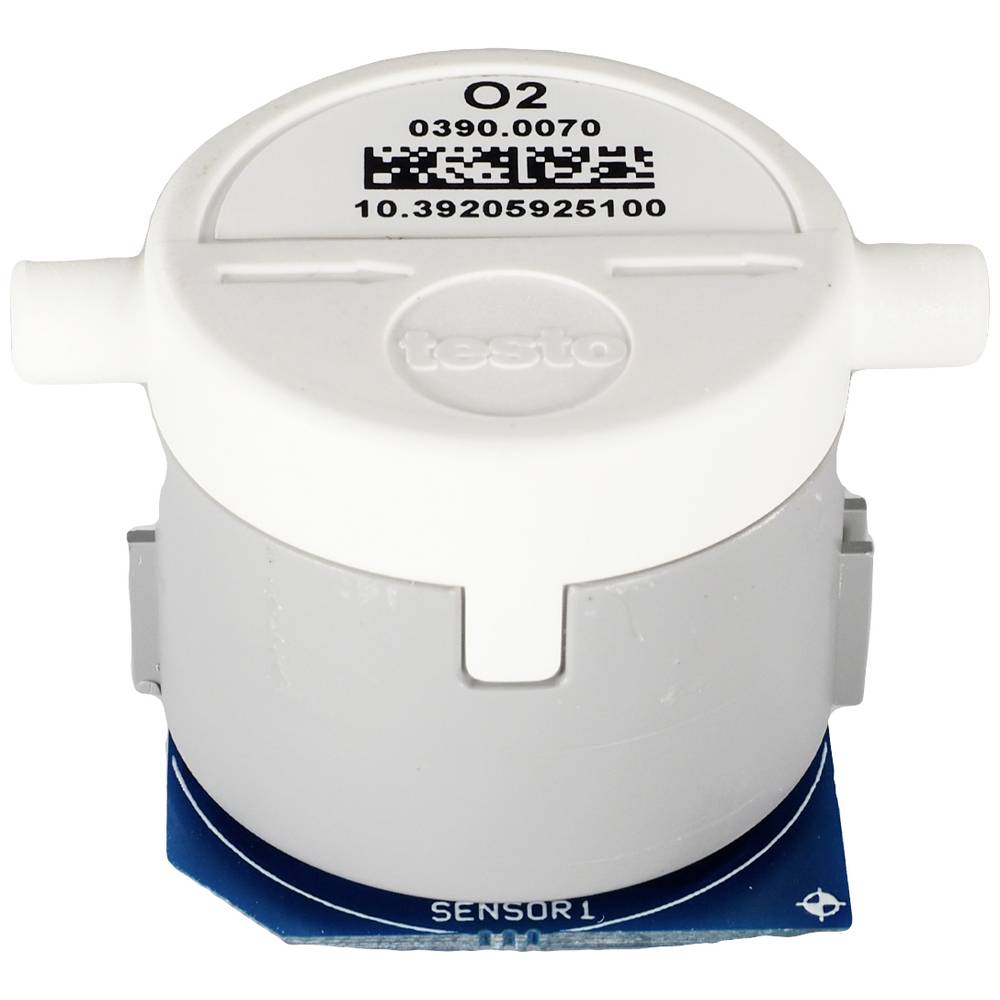
Looking for a replacement oxygen sensor for your flue gas analyzer? Check out the Testo 0390 0070 model and learn how to install it with our simple instructions.
Of course, there are many other O2 oxygen sensors but today let’s talk about the 0390 0070.
Here are the digital flue gas analyzers which are suited for Testo 0390 0070:
- Testo 300 M
- Testo 300 XL
- Testo 300 M-I
- Testo 300 XL-I
- Testo 300 XXL
- Testo 335
- Testo 350 M
- Testo 350 XL
Other specifications:
Package Dimensions: 41.9 x 24.1 x 14.8 cm
Item Weight: 30 g
Measuring range: 0 - 25 vol.%
So, why do you need an O2 sensor?
It’s for measuring oxygen levels remaining in the flue exhaust gas. You need a tool called a flue gas analyzer (combustion analyzer). There are many different instruments on the market but nearly all of them include an O2 oxygen sensor like the 0390 0070.
That’s why you need an oxygen sensor.
Good news is that it’s pre-calibrated too so you won’t need to calibrate yourself. Simply plug in the sensor and you are all set.
Okay, so how to replace a faulty sensor?
It’s not too difficult to change the O2 sensor for your flue gas analyzer. You'll be able to replace the faulty sensor with ease and get back to accurate measurements in no time.
To ensure a seamless replacement process, please follow these simple steps:
1. Switch off the measuring instrument.
2. Carefully place the instrument on its front.
3. Unscrew and lift up the service cover.
4. Disconnect the hose connections from the faulty sensor/bridge.
5. Remove the old sensor/bridge from its slot.
6. Install the new sensor/bridge securely in the designated slot.
7. Push the hose connections onto the new sensor/bridge.
8. Refit and close the service cover.
Remember, after replacing an O2 sensor, allow a 60-minute equalization period before using the instrument again for accurate readings.
If you still have questions, please watch this short video on Youtube to clear any remaining confusion.
Here’s the video: https://www.youtube.com/watch?v=1gCsyZ_r1Nc&list=LL&index=1
Meanwhile, if you need to purchase a brand new Testo 0390 0070 oxygen sensor then you can easily do it by clicking this link to go to our webstore - click here!
Cart
Cart is empty.